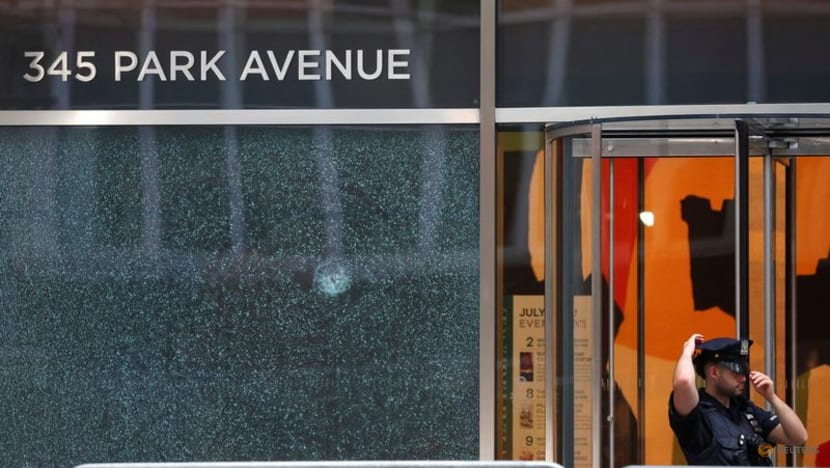Manhattan shooting renews focus on CTE, concussion risks in amateur sports


NEW YORK :A deadly Manhattan office shooting by former high school football player Shane Tamura has renewed attention on how head injuries are managed in amateur football.
Tamura, 27, fatally shot four people before killing himself, leaving a note blaming chronic traumatic encephalopathy, or CTE, and the NFL for his actions. National Football League headquarters are in the Park Avenue building where the shooting occurred.
Tamura, who played at a Los Angeles charter school, had not been diagnosed with CTE, which can only be confirmed post-mortem. New York City's Office of Chief Medical Examiner said it will conduct a neuropathological assessment during his autopsy, with results expected in a few weeks.
But persistent questions about the effectiveness of strategies for tracking and managing repeated head trauma in young athletes are again facing scrutiny.
Karissa Niehoff, CEO of the National Federation of State High School Associations that oversees high school football in the U.S., said her organization "does not know how many serious concussions are reported each year.”
"Concussions occur among all age groups and in many activities, but are often not reported. Those at the scholastic level might involve reporting to a school nurse, athletic trainer, or coach," Niehoff said.
Concussions are sometimes called "snowflake injuries" to reflect their unique and unpredictable nature. Monitoring student-athletes is difficult for organizations like the NFHS, since state associations have no oversight once students graduate.
A 2023 Boston University CTE Center study that examined the brains of 152 youth, high school, and college athletes, most of them football players, who had died under age 30, found 41 per cent showed signs of CTE.
Suicide was the most common cause of death, but not all athletes with symptoms had CTE, the study found. There was no statistically significant difference in clinical symptoms between those with the brain disorder and those without.
"They only played high school or college level and still had developed the changes of CTE," said Boston Center Director Ann McKee.
"It's not well understood that kids playing amateur level sports are at risk. This isn't a disease only of pro athletes," she said, calling it a public health issue. "There's an urgent need to address it at the amateur level."
According to NFHS data, about 30 per cent of athletes with concussions may have symptoms lasting over four weeks. The NFHS has not labelled brain injuries in amateur sports a public health concern, in contrast to the Boston CTE Center.
Protocols are in place to protect athletes suspected of incurring head injuries, requiring immediate removal from play at all levels. However, there are major differences between professional and amateur protocols.
The NFL uses a five-step return-to-play process, including evaluation by an independent neurological consultant. Most high schools cannot afford independent neurologists, relying on athletic trainers, who may lack specialized concussion training, to assess injured players.
Technology also plays a role in player safety. Professional teams use helmet impact sensors and analytics to monitor hits. High school programs rarely have access to such technology and rely on visual observation and self-reporting by athletes, who may feel pressure to keep playing.
"We know that many changes have been made in sports to address potential head injuries," Niehoff said. "We also know that as we learned more about concussions, the number of reported concussions increased."
AGGRESSION NOT A UNIVERSAL SYMPTOM
Some individuals with CTE show increased aggression, but violence is not a universal symptom.
Several ex-NFL players, including Jovan Belcher, Irv Cross, Conrad Dobler, Chris Henry, Vincent Jackson, Terry Long, Junior Seau, Demaryius Thomas and Frank Wycheck, were found to have CTE after their deaths.
Some faced behavioral or mental health challenges such as dementia and depression following distinguished careers in the violent sport. Long, Seau, and Belcher died by suicide. Belcher fatally shot his girlfriend before taking his own life.
Former New England Patriots tight end Aaron Hernandez was convicted of murder and died by suicide in prison at age 27. A posthumous examination revealed severe CTE.
"Aggressive behaviour can be part of the syndrome, but it isn’t universal and we don't know why some patients develop it and others don’t," said Dr. Brent Masel, executive clinical professor of neurology at the University of Texas.
"We can't explain where the problem lies in the brain. We’re miles away from trying to figure that out," he said. "Just like with Alzheimer’s disease, some become aggressive and some don't. Why that happens and whom it happens to, we don't know.”
Progress in prevention and treatment has been slow.
"We really haven't moved the needle much relative to the prevention of CTE... except we’re a little better in treating the symptoms," said Masel.
"Not every athlete with a history of contact sports who develops psychiatric issues is going to go on to develop this problem," he said.
"The last thing you want is everybody in a panic that their child is going to end up doing something like that," Masel said. "So the most important thing is to reassure the public that the chances of their child ending up doing what Tamura did are slim."













